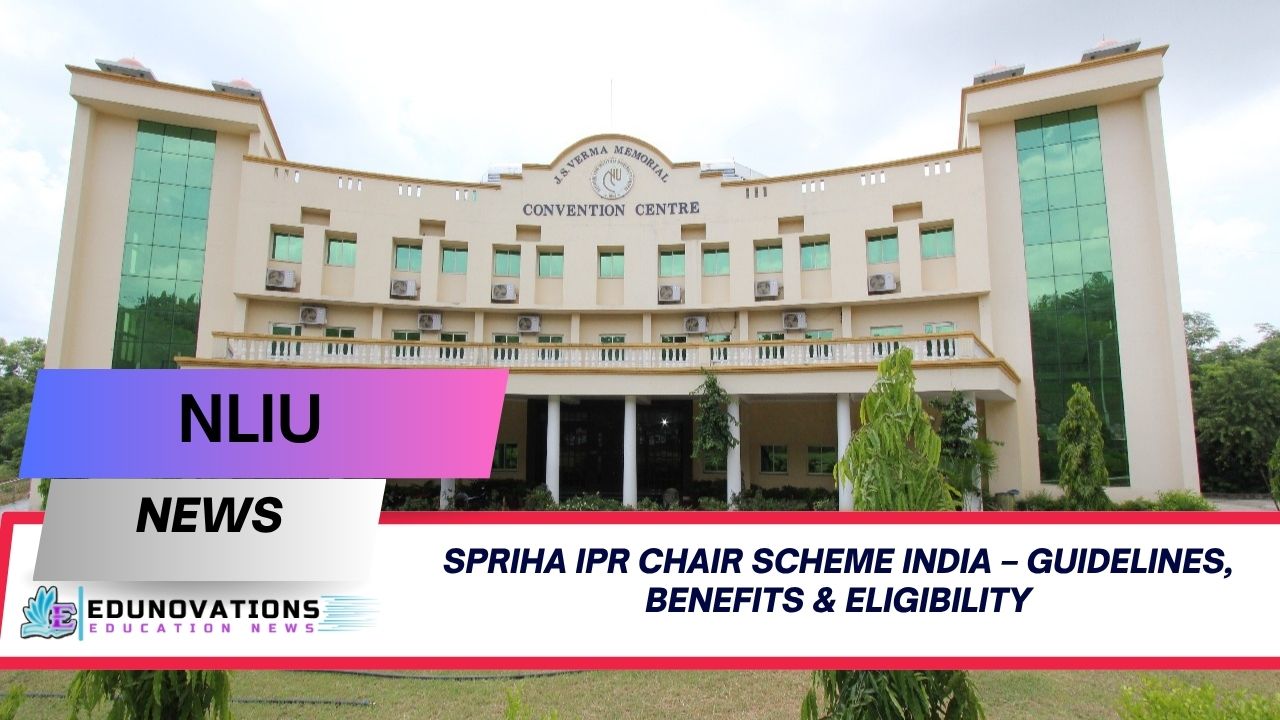Learn how the SPRIHA IPR Chair Scheme India is shaping legal education and research in intellectual property rights. Discover eligibility, funding, and application process.
Introduction
India’s growing commitment to strengthening intellectual property (IP) literacy across higher education is gaining momentum, especially with the SPRIHA IPR Chair Scheme India—a significant initiative launched by the Department for Promotion of Industry and Internal Trade (DPIIT). The program, formally known as SPRIHA: Scheme for Pedagogy & Research in IPRs for Holistic Education & Academia, aims to transform IP education by fostering research, innovation, and holistic development through the creation of IPR Chairs in prestigious academic institutions.
In an era where IP is integral to economic growth and technological development, this scheme is designed not just as a funding support but as a catalyst for nurturing future leaders in IPR policy, law, and education.
What is the SPRIHA IPR Chair Scheme India?
The SPRIHA IPR Chair Scheme India is an institutional initiative rolled out under the National IPR Policy 2016, which mandates capacity-building in intellectual property rights across academic institutions. It provides a framework for establishing dedicated IPR Chairs responsible for advancing IP education, research, and awareness.
This scheme offers comprehensive support including funding, infrastructure guidelines, deliverable benchmarks, and evaluation metrics. It is targeted at central universities, law colleges, and research bodies with a robust academic track record in IPR or law.
Objectives of the SPRIHA IPR Chair Scheme
The core vision behind this scheme is to foster an ecosystem where intellectual property becomes an academic discipline as rigorous and mainstream as traditional law or science. Key objectives include:
- Promoting pedagogy and research in IPRs guidelines aligned with global standards.
- Encouraging capacity-building among educators and students.
- Supporting interdisciplinary IP education that includes law, science, technology, and economics.
- Facilitating dialogue and dissemination of IPR knowledge via workshops, seminars, and academic courses.
- Enhancing India’s IP ecosystem to drive innovation and entrepreneurship.
Eligibility Criteria: Who Can Apply?
Institutions aiming to participate in this initiative must fulfill certain basic and academic prerequisites. Here’s what makes an institute eligible:
- Must be a government-funded central/state university or a university applying for SPRIHA funding with active programs in law, management, science, or technology.
- Demonstrated capability in IP teaching and research.
- Adequate infrastructure to host a full-time SPRIHA IPR Chair Professor.
- Transparency in fund utilization and audit mechanisms.
Applicants must submit a proposal detailing their vision, proposed activities, and plans for capacity-building, aligning with SPRIHA research guidelines for IPR.
Roles and Responsibilities of the IPR Chair
Once established, the IPR Chair assumes multiple responsibilities, including:
- Development of IP curricula tailored to UG/PG law or technical courses.
- Hosting IP-related seminars, conferences, and SPRIHA capacity-building programs.
- Publishing annual reports and research output in reputed journals.
- Offering legal assistance and awareness services to innovators and MSMEs.
The IP teaching pedagogy under SPRIHA prioritizes hands-on involvement, bridging academic knowledge with industry relevance.
Toppers Use Mind Maps to score more than 95%
NCERT Class 11th Commerce Mind Maps
Add to cartOriginal price was: ₹999.00.₹199.00Current price is: ₹199.00.NCERT Class 12th Chemistry Mind Maps
Add to cartOriginal price was: ₹199.00.₹75.00Current price is: ₹75.00.NCERT Class 12th Commerce Mind Maps
Add to cartOriginal price was: ₹999.00.₹199.00Current price is: ₹199.00.NCERT Class 12th Science Mind Maps
Add to cartOriginal price was: ₹999.00.₹199.00Current price is: ₹199.00.NCERT Mind Maps For Class 10th
Add to cartOriginal price was: ₹999.00.₹199.00Current price is: ₹199.00.
Purchase Today
Funding Details and Financial Support
DPIIT will fund institutions through annual grants under this scheme. The financial support includes:
- A recurring grant to cover the salary of the SPRIHA IPR Chair Professor.
- Seed money for organizing workshops, seminars, and promotional events.
- Support for library resources, journal subscriptions, and educational tools.
Financial proposals must follow a strict format as per SPRIHA grant application process DPIIT, ensuring transparency and justifiable expenditure.
Monitoring and Evaluation Mechanism
DPIIT, through the Cell for IPR Promotion and Management (CIPAM), will monitor the performance of each Chair annually. Evaluation is based on:
- Number of events conducted
- Quality of research published
- Student and faculty engagement levels
- Outreach and public awareness
Non-performing institutions risk termination or funding suspension.
Advantages of SPRIHA for Indian Academia
The SPRIHA IPR Chair Scheme India is not just another grant program—it is a nation-building initiative. Here’s how it benefits Indian academia:
- IPR curriculum development guidelines ensure that academic institutions align their programs with industry needs.
- Encourages the infusion of real-world legal practices into university learning.
- Empowers faculty through training and resources.
- Connects Indian institutions with global IP policy frameworks and collaborations.
National Impact and Stakeholder Reception
Since the scheme’s announcement, academic leaders and policy makers have lauded its potential. According to Prof. Rajat Sharma, a renowned IP scholar at JNU, “SPRIHA can revolutionize IP research in India if implemented with commitment. It aligns perfectly with NEP 2020’s interdisciplinary goals.”
Educational technology platforms such as EduNovations have expressed interest in curating specialized learning resources aligned with the scheme’s goals. Their NCERT Courses, Current Affairs, and Notes sections can integrate IPR content for broader outreach.
Implementation Strategy for Institutions
To benefit from the scheme, institutions should:
- Form a dedicated committee to design a project proposal.
- Consult experienced IP professionals or industry partners.
- Draft a clear budget in line with SPRIHA financial proposal format.
- Ensure transparency in resource use and staff hiring.
- Regularly publish progress and research findings.
Those looking to digitize their educational content or set up compliant institutional websites may reach out to service providers like Mart India Infotech, specializing in education technology infrastructure.
Enhancing Visibility Through Events and Research
Chairs are expected to conduct impactful seminars and conferences. These events should engage policymakers, legal experts, technologists, and student bodies. Institutions are also encouraged to publish a minimum of four research papers per year.
Engaging with the broader community through MCQs, syllabus, or mind maps on platforms like EduNovations can help extend awareness about IPR to a wider academic audience.
Conclusion
The SPRIHA IPR Chair Scheme India stands at the crossroads of innovation, education, and national development. By bridging academic rigor with policy relevance, it empowers institutions to cultivate a new generation of IP-savvy scholars, legal professionals, and innovators.
As India strengthens its position in the global knowledge economy, initiatives like SPRIHA will be central to creating a vibrant, self-reliant, and IP-respectful ecosystem. Institutions, students, and educators must seize this opportunity to transform intellectual property into a pillar of academic excellence.
FAQs on SPRIHA IPR Chair Scheme India
1. What is the main objective of the SPRIHA IPR Chair Scheme India?
The scheme aims to promote structured education and research in intellectual property rights across Indian academic institutions.
2. Who is eligible to apply under SPRIHA IPR Chair Scheme India?
Government-funded central or state universities with legal or technical programs are eligible.
3. How to apply for SPRIHA funding for universities?
Institutions must submit a detailed proposal aligning with the scheme’s objectives to DPIIT via CIPAM.
4. What kind of support does the scheme provide?
The scheme offers funding for a chair professor, events, library resources, and IP research infrastructure.
5. What are the roles of a SPRIHA IPR Chair Professor?
They are responsible for curriculum design, conducting workshops, guiding research, and publishing scholarly work.
6. What is the expected output from SPRIHA research guidelines for IPR?
High-quality interdisciplinary research papers, policy inputs, and academic programs focused on IPR.
7. How are institutions evaluated under the scheme?
Through performance audits based on event impact, research publication, and student engagement.
8. Can private colleges apply for the scheme?
No, the scheme is currently limited to public universities and government-supported institutions.
9. What are the SPRIHA capacity-building programs?
These include faculty development, student workshops, IPR clinics, and public awareness campaigns.
10. How does this scheme benefit Indian students?
It equips students with real-world IPR knowledge, boosting their employability and entrepreneurial readiness.














